
Effect of Sulfakinin/Cholecystokinin-type Peptide ArSK/CCK1 on Satiety and Energy Metabolism of Asterias vulgaris
Abstract¶
Depression is the persistent sadness or lack of interest in previously rewarding activities and has devastating effects on much of the global population. The neuropeptide cholecystokinin (CCK) controls satiety in humans and travels along a signaling pathway related to the brain-gut axis in humans. This suggests a relationship between the pathway and experienced emotions in relation to depression. Increased levels of CCK have been correlated with increased suicide attempts, and the effects of CCK-like pathways in arthropods have exhibited an increased correlation between peptide levels and feelings of satiety. Though a similar pathway (using the ArSK/CCK neuropeptide) has been identified in the evolutionarily proximal echinoderm Asterias rubens, little is known about the effects of these peptide levels on depressive symptoms through observation of feeding and energy metabolism. This study observed the effect of injected ArSK/CCK1 peptide on satiety and energy homeostasis through examination of initial and final stomach eversion areas of Asterias vulgaris, synonymous with A. rubens. Energy homeostasis was observed using a constructed open-flow respirometer taking measurements, which predicted energy creation using the rate of dissolved oxygen consumption to be used for cellular respiration. Exposure to ArSK/CCK1 was found to yield lower rates of dissolved oxygen decrease compared to basal rate and control measurements, suggesting a resulting decreased satiety and rate of energy metabolism.
Introduction¶
Depression, defined as the persistent sadness and lack of interest or pleasure in previously rewarding activities, affects much of the world today. It is one of the most prevalent mental health disorders in the United States and the second leading cause of disability worldwide, proving to be an immense global and economic burden in addition to the emotional distress felt by those affected. Some symptoms of the disease include feelings of sadness or hopelessness, sudden angry outbursts, reduced appetite, and anxiety. Despite the large quantity of research done on the topic, the exact mechanisms underlying depression are unknown. However, research has shown that changes in the gut microbiome (the variety of microorganisms living in the digestive tract) play an important role in the brain-gut axis, and thus hold influence in the neural and immune systems. More specifically, changes in the composition of the gut microbiome in mice have caused the demonstration of resilience when exposed to stress Chang et al., 2022.
Cholecystokinin (CCK) is a neuropeptide, or chemical messenger, synthesized by neurons and involved in a signaling pathway along the brain-gut axis. The peptide hormone was discovered and named due to its stimulatory effects on gallbladder contraction as well as the gastric secretion of pepsin and acid in mammals Ivy & Oldberg, 1928. Neuropeptides such as CCK are composed of small chains of amino acids and are synthesized and released by neurons, binding to G protein-coupled receptors to modulate tissue activity. CCK is an important moderator of food intake and energy homeostasis, having been found to generate anxiety and aggression once simulated in mice Singh et al., 1991. Increased levels of CCK are related to stronger feelings of satiety as well. In human patients suffering from depression, significant inverse correlations were found between CCK levels and depression and anxiety parameters. Patients who had made one or more suicide attempts generally had higher CCK levels in their cerebrospinal fluid (CSF) than those who had not Löfberg et al., 1998 .
A CCK-type pathway has been discovered in a variety of insects, with similar G Protein Coupled Receptors that act as receptors for these CCK-like signaling molecules. Named sulfakinins (SKs), these neuropeptides have proven to be a family of neuropeptides homologous to mammalian CCK and caused the reduction of food intake by either direct peptide injection Wei et al., 2000 or SK gene silencing Meyering-Vos & Müller, 2007 , similar to the effect of CCK in mammals. The homologous nature of CCK and SK suggests that insects with SK signaling pathways can serve as model organisms utilized in the study of CCK signaling pathways Yu et al., 2013. Its inhibitory action on feeding in insects has been quantified and discovered to affect the regulation of insulin-like peptides and carbohydrates in insect hemolymph Słocińska et al., 2020.
The presence of SK-type signaling in various insects and arthropods indicates that SK/CCK-type signaling has evolutionary origins in the common ancestor of Bilateria. These signaling systems have similarly been discovered in protostome invertebrates such as the nematode Caenorhabditis elegans and mollusk Crassostrea gigas Janssen et al., 2008;Mirabeau & Joly, 2013. The roles of SK/CCK-type signaling in non-arthropod protostomes also play a role in digestion regulation similar to ones observed in mammals. These include a decrease in the frequency of contractions for the hindgut as well as the regulation of energy storage and feeding in C. gigas Schwartz et al., 2018.
Sharing a position under the category of deuterostomes similar to chordates, echinodermata hold an intermediary position in the phylogenetic position between vertebrata and arthropoda, in which CCK-type signaling pathways have been commonly observed Semmens et al., 2016. This intermediary phylogenetic position makes echinodermata a more accurate model for such pathways, as organisms share a more recent common ancestor with chordata when compared to arthropoda. CCK-type immunoreactive cells have been discovered in the intestines of sea cucumbers from the phylum echinodermata, and the use of vertebrate CCK-type peptides was also observed to cause the relaxation of sea cucumber intestines García-Arrarás et al., 1991. The amino acid sequences of native SK/CCK-type neuropeptides in sea cucumbers have also been identified, yielding possibilities for studies regarding its pharmacological effects in sea cucumbers Chen et al., 2019.
Asterias rubens, or the common sea star, is a European starfish typically found in the northeast Atlantic Ocean. Favored due to its wide availability, A. rubens has served as a model organism for processes ranging from salinity tolerance Sarantchova, 2001 to immune response Matranga et al., 2012. Recently, a study characterized SK/CCK-type signaling for A. rubens, the first such characterization for non-chordate deuterostomes Tinoco et al., 2021. Two CCK-type neuropeptides (ArSK/CCK1 and ArSK/CCK2) were successfully derived from the precursor protein ArSK/CCKP and were found to travel along a similar signaling pathway. They are expressed in the nervous system, digestive system, tube feet, and body wall of A. rubens, causing feeding inhibition and cardiac stomach retraction similar to the observed effect of CCK-type signaling in other organisms. Comparison of the peptide sequences composing ArSK/CCK1 and ArSK/CCK2 with SK/CCK-type neuropeptides from other taxa indicate the shared presence of tyrosine (typically sulfated) and a C-terminal amide group also characteristic of most SK/CCK-type peptides Tinoco et al., 2021.
Little is known about the quantitative effect of CCK-type signaling on energy homeostasis in Ambulacraria including echinoderms and hemichordates, or invertebrates in an intermediate phylogenetic position between protostomes such as arthropoda and chordates Furlong & Holland, 2002. With depression, little work has been done to observe the effects of natural antidepressant compounds on the CCK-type signaling pathway in relation to energy homeostasis and feeding behavior. This experiment aims to quantitatively explore the effect of increased levels of CCK-type neuropeptides on energy homeostasis by observing the resulting changes in dissolved oxygen in the water surrounding A. vulgaris. This will be done by creating an open-flow respirometer and presenting a quantitative perspective on energy homeostasis as a means of predicting cellular respiration rates, with higher rates accompanied by increased dissolved oxygen consumption and vice versa. Due to the homologous nature of A. rubens and A. vulgaris, it is predicted that the SK/CCK-type neuropeptides sequenced from A. rubens will similarly cause cardiac stomach contraction and feeding inhibition in A. vulgaris. Increased levels of CCK-type peptides are predicted to cause a lower rate of dissolved oxygen decrease, thus indicating the decreased production of energy through cellular respiration.
Methods¶
Animal Care and Maintenance¶
Adult Asterias vulgaris (synonymous with the common sea star Asterias rubens) were acquired from the Gulf of Maine (736 Leighton Point Rd. Pembroke, Maine 04666) and kept in a 10-gallon tank at 4.8 degrees Celsius. Saltwater was used in the tank and was prepared with 31.2 mL of InstantOcean aquarium salt for every 1 liter of distilled water. Water was chilled to aquarium temperature and conductivity was measured relating to salinity (about 308) before each water replacement. 3 liters of tank water were replaced once or twice a week.
Organisms were exposed to a 12-hour light/dark cycle to model their natural environments (Seaoura Aquarium Light was used) and clams were fed as a food source every 2-3 days see Figure 1. For each feeding, clams were dropped into the tank in proximity to the organisms and were taken out the next day to prevent excessive bacterial growth. An aquarium filter (PULACO Aquarium Internal Filter) was used to maintain water condition and provide aeration to the water. The filter cartridge was replaced once every month with Tetra Whisper Bio-Bag Filter Cartridges. Temperature probes were placed in the tank and hooked up to a Vernier LabQuest sensor to monitor tank temperatures at all times.
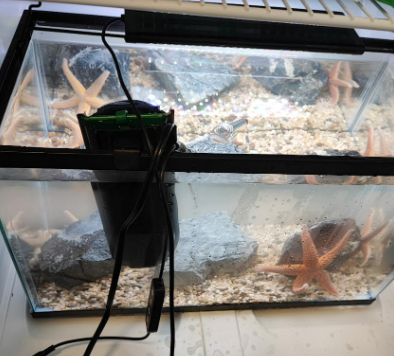
Figure 1:Organisms in their natural environments
Respirometer Design and Construction¶
An open-flow respirometer was constructed to reduce stress upon the model organism according to a basic structure described by Drown et al., 2020 with modifications to measure oxygen consumption in relation to energy metabolism. The chamber the organism was placed in was made of a 9.6-cup plastic Rubbermaid container with holes drilled in the lid for rubber tubing. A Stepper peristaltic pump (24V) was used to cycle water throughout the system in a clockwise manner drawing water away from the chamber (at approximately 268 rpm). The water exiting the chamber entered another chamber (plastic, empty 100 mL distilled water bottle with a hold drilled in lid) containing a Vernier dissolved oxygen sensor hooked up to a Vernier LabQuest sensor monitoring dissolved oxygen levels in the closed system. This chamber was placed in a water bath to exert external pressure and prevent leakage and air exchange out of the container.
All chambers and the pump were connected via ANPTGHT " by " aquatic connectors (between tubes and chambers) and sealed with aquarium sealant (Loctite 2.7 oz Clear Silicone Waterproof Sealant) to prevent water and air leakage. A Horiznext brass " O.D. three-way brass ball valve was used as the control center to control the cycling of water in the closed “loop” and “flush” cycles (oxygenated water cycled through the system). Both chambers containing organisms and the bin containing oxygenated water supply were kept on ice with salt to maintain a constant temperature during cycles. All water was cycled through the system with the same composition as the original tank water (saltwater solution) and an added 2% Magnesium chloride solution (20 g of magnesium chloride hexahydrate to every 1 L of distilled water). See Figure 2 for a visualization of the respirometer.
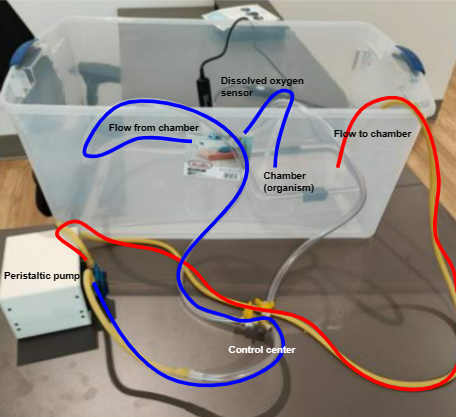
Figure 2:Respirometer diagram
In Vivo Tests on Stomach Contraction¶
Measurement of satiety was performed using in vivo tests observing stomach contraction. Organisms were deprived of food supply for 10 days before experimentation and placed in the organismal chamber of the respirometer and exposed to a 2% magnesium chloride solution in the organismal chamber, a marine muscle relaxant Tinoco et al., 2021. After about 30 minutes or when stomach eversion has been observed for a period of time, the chamber was closed and a cycle was run for 180 seconds. Data was tracked with the Vernier Dissolved Oxygen probe and a line of best fit was observed for the dissolved oxygen levels across the 180 seconds. The slope of the line of best fit was noted as the change in dissolved oxygen consumption (mg/L/s). This was repeated a series of times for each A. vulgaris of differing diameters and established their basal rate of dissolved oxygen consumption. The correlation coefficient (r2 value) was noted for each slope and only r2 values with an absolute value of 0.5 or higher were considered in data analysis. A flush cycle was used to reoxygenate the water when oxygen levels were getting low between trials and to aid in the cleaning of the respirometer.
For the control experiment, each of the A. vulgaris was injected with 10 microliters of distilled water for a 12 cm diameter starfish using a Model 7001KH 1 microliter Hamilton syringe. Volumes of water injected were adjusted accordingly with varied diameters of organisms and the needle was disinfected with 70% ethanol before and after use. The injections were performed with the tip of the needle facing the central disk of the organism and at the base of each arm (5 microliters at the base of one arm and 5 at the base of another, care was taken to inject the liquid into the coelomic cavity of the organism, see Figure 3). Water was cycled through in the manner described above, and flush cycles were performed to reoxygenate the water. Data was collected in accordance to the standards presented above.

Figure 3:Size measurement, injection, and data collection process
The same process was repeated with 10 microliters of the neuropeptide ArSK/CCK1 (peptide sequence pQSKVDDY(SO3H)GHGLFW-NH2, synthesized by ThermoFisher) for a 12 cm starfish of the experimental group. The peptide injected was adjusted for concentration and volume and was diluted according to the diameter of the organism. The concentration of the neuropeptide was chosen due to its ability to form a more pronounced difference and caused the greatest effects on in vitro preparations of the cardiac stomach during prior experimentation Tinoco et al., 2021. Cycles were not run until an observed cardiac stomach retraction occurred, signaling the effects of the peptide had taken place and dissolved oxygen levels observed reflected this state of satiety. Data was collected in accordance to the standards presented above.
Results¶
Effectiveness of Respirometer in Measuring Dissolved Oxygen Consumption¶
The effectiveness of the open-flow respirometer in measuring dissolved oxygen consumption rates as a reflection of energy metabolism was observed by changes in dissolved oxygen levels in cycling water in the presence and absence of A. vulgaris. Rates of dissolved oxygen change in the closed system were measured in 180-second intervals across the span of several days and yielded an average rate of 0.00697 mg/L/s. All values yielded a positive value, thus indicating that dissolved oxygen was not consumed by the system.
Asterias vulgaris were also placed in the organismal chamber to observe rates of dissolved oxygen consumption. All rates observed across several days for each organism yielded negative values, indicating a decrease in dissolved oxygen levels with the presence of A. vulgaris, and thus the respirometer was an effective measurement for dissolved oxygen consumption in reflection of energy metabolism.
Measurement of Dissolved Oxygen Consumption¶
The rates of dissolved oxygen consumption were measured at basal rate, H2O injections (control), and ArSK/CCK1 injection (experimental) for each organism. Measurements for each organism of varied diameter were taken individually for groups but were averaged for consideration together with values from other organisms for final comparison across sections.
Across all organisms of varying diameters, the basal rate measurements yielded the highest rate of decrease for dissolved oxygen overall with the strongest negative values see Figure 4. This illustrates the highest amount of dissolved oxygen consumption and a reflected energy production in the organism. The dissolved oxygen consumption rate measurements for the control (H2O injection) fell near the measurements for the basal rate as well, tending to hold a rate slightly lower than the basal rate measurements. Dissolved oxygen consumption rates for the experimental peptide injection group showed much less change in dissolved oxygen levels, however, with rate values approaching or greater than zero. This suggests a general decrease in the amount of dissolved oxygen consumed by A. vulgaris under exposure to ArSK/CCK1.
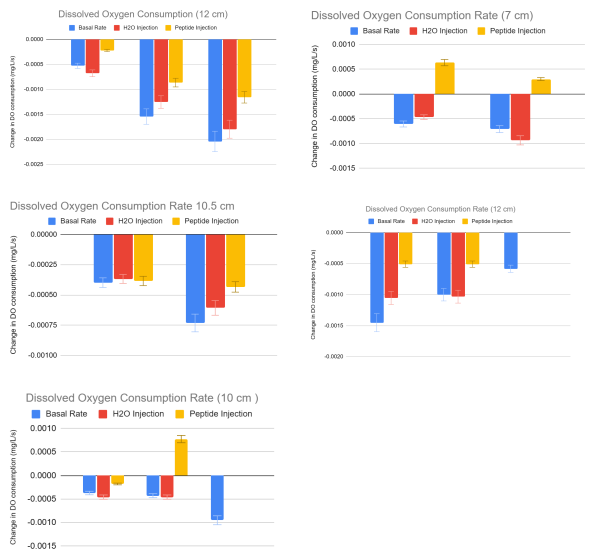
Figure 4:Dissolved oxygen consumption rates for all tested organism diameters with data from basal rate, control, and experimental groups.
The average change in dissolved oxygen consumption was taken across all organisms and averaged to achieve a value for comparison. To establish the validity of the H2O injection as a control, the average change in dissolved oxygen consumption for the basal rate and H2O injection measurements were compared. A one-tailed T-test was performed for the two means to determine if the average dissolved oxygen consumption rate for the basal rates (-0.00087 mg/L/s) was significantly greater than the average rate for the H2O injection (-0.00083 mg/L/s), as shown in Figure 5. A p-value less than 0.05 was acquired, thus demonstrating that the difference between the two values was not significant and factors such as the injection process or addition of fluid into the coelomic cavity did not have a significant impact on the results obtained.
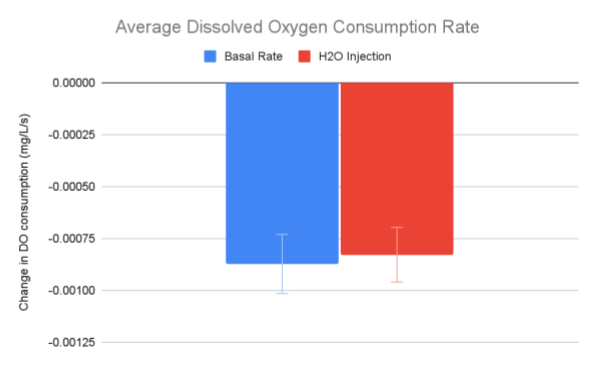
Figure 5:Comparison of average basal rate across all included trials and dissolved oxygen consumption from the control groups exhibited no statistically significant difference (p-value of 0.411203 on a 95% confidence interval). The injection process was then determined to not yield a significant effect on dissolved oxygen consumption rates. Basal rate measurements can be compared with results from the experimental groups.
The quantitative effects of exposure of ArSK/CCK1 on the dissolved oxygen consumption of A. vulgaris was observed by averaging the rate values from all organisms and trials considered see Figure 6. This average (-0.00023 mg/L/s) was compared to the average dissolved oxygen consumption rate for the basal rate group with a one-tailed t-test. A p-value greater than 0.05 was achieved, indicating that the average rate for the ArSK/CCK1 injection group was significantly lower than that of the basal rate.
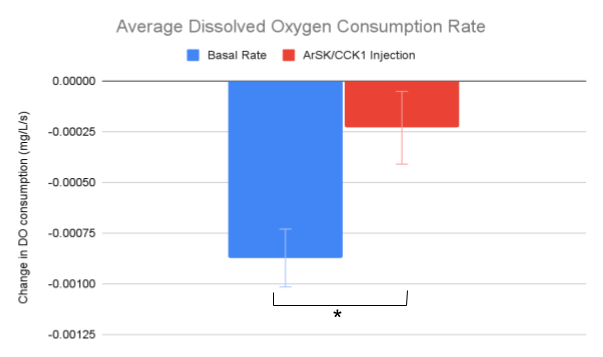
Figure 6:Comparison of average basal rate across all included trials and dissolved oxygen consumption from the experimental groups displayed a statistically significant difference (p-value of 0.004776 on 95% confidence interval), indicating that exposure to ArSK/CCK1 yielded a significant difference in the amounts of dissolved oxygen consumed.
Discussion¶
This study observed the effects of cholecystokinin-type neuropeptide ArSK/CCK1 on the organism Asterias vulgaris with consideration of its satiety-producing effects on dissolved oxygen consumption and thus energy metabolism in the organism. In considering depressive symptoms such as appetite and energy loss, this study indicated the potential of the CCK homolog ArSK/CCK1 in studies of appetite and emotional health disorders as a reflection of the mammalian CCK.
The measurement of dissolved oxygen consumption as an indicator of energy metabolism in A. vulgaris was established based on its consumption in the process of cellular respiration to produce ATP for cellular processes. This measurement was performed through the construction of an open-flow respirometer utilizing a Vernier dissolved oxygen sensor which effectively monitored dissolved oxygen changes in the presence and absence of an organism. The tubes connecting the chambers and the pump were sealed with aquarium sealant in an attempt to create an airtight seal, though small amounts of oxygen were able to enter through small gaps during the cycles. This caused there to be a net gain of dissolved oxygen instead of the expected constant value, though this was worked around by comparing the experimental rates with the average net gain of the respirometer. As no dissolved oxygen consumption rates yielded a value greater than the average net gain of the respirometer, it was able to indicate the desired dissolved oxygen changes and served the purpose of this experiment.
The exposure of A. vulgaris to the neuropeptide ArSK/CCK1 via injection demonstrated a decreased rate of dissolved oxygen consumption when compared to measurements of basal rate. This trend was observed across A. vulgaris of differing diameters and slight variations in lengths of starvation time. Though a base starvation interval of ten days was applied for the organisms, the time needed for the acquisition of each data point caused some organisms to be starved for more than ten days at the time of experimentation. However, the effects of ArSK/CCK1 exposure for all organisms followed a common trend throughout experimentation regardless of specific starvation times and thus suggests that it held minimal impact on the effect of the neuropeptide on behavior.
Observations of satiety and abstinence from feeding representing appetite loss were perceived through stomach eversion amounts in 2% magnesium chloride solution. Despite the slightly differing intervals of starvation organisms were exposed to, cardiac stomach eversion was observed with exposure to the MgCl2 solution before the performance of any measurements or experimental injections. In cases of injection, dissolved oxygen was able to enter the system when the organismal chamber was opened to perform experimental procedures, preventing oxygen levels in the water from getting too low in the following trials. Cardiac stomach inversion was noted with the administration of ArSK/CCK1 as an indicator of satiety, and dissolved oxygen rate data was not collected until its effects were observed to ensure that the data collected represented its effects.
Conclusion¶
Induced appetite loss in the state of starvation has been shown to decrease energy production in relation to dissolved oxygen consumption, proving A. vulgaris as an adequate model for depression studies as a homolog to mammalian CCK signaling pathways. Acquisition of data points with a correlation ( greater than 0.5) demonstrated a correlation between the points composing a dissolved oxygen rate measurement, yielding higher confidence in the validity of the rate in reflecting the general changes in dissolved oxygen observed. This parameter also caused the elimination of many data points, however, and resulted in a smaller number of values that could be interpreted in the data. Future work would include performing increased trials and acquiring more basal rate, H2O injection, and ArSK/CCK1 injection data points.
Concentrations of ArSK/CCK1 selected in this study were based on optimal in vitro muscle contractions Tinoco et al., 2021. Varying concentrations and volumes of ArSK/CCK1 could be tested to observe its effects on energy metabolism in A. vulgaris and determine the relationship between peptide concentration and degree of appetite loss. While ArSK/CCK1 was tested in this study, further studies could utilize the homolog ArSK/CCK2 and observe the effects of its exposure to dissolved oxygen consumption and energy production Tinoco et al., 2021.
The prospect of these signaling pathways in modeling depression opens up further questions regarding prospective treatments that target its behavior. With the establishment of A. vulgaris as an adequate model organism for studying ArSK/CCK1 signaling with its impact on satiety, this study observed its impact on the energy loss aspect of depression. Further research that could be done would include the observation of ancient herbal medicinal extracts such as Ziziphus jujube that had previously exhibited antidepressant effects in stress-related studies involving mammals Oh et al., 2020Park et al., 2019. Oral administrations or a filtered extract administered by injection can be utilized to observe its impact on satiety and energy metabolism measurements McLean et al., 2016.
The author would like to thank Jennifer Williams, North Carolina School of Science and Mathematics-Morganton, and Ana B. Tinoco for their guidance and support throughout the course of this project.
Copyright © 2024 Zhang. This is an open-access article distributed under the terms of the Creative Commons Attribution 4.0 International license, which enables reusers to distribute, remix, adapt, and build upon the material in any medium or format, so long as attribution is given to the creator.
- CCK
- Choleocystokinin
- SK
- Sulfakinin
- SKs
- Sulfakinins
- Chang, L., Wei, Y., & Hashimoto, K. (2022). Brain–gut–microbiota axis in depression: A historical overview and future directions. Brain Research Bulletin, 182, 44–56. 10.1016/j.brainresbull.2022.02.004
- Ivy, A. C., & Oldberg, E. (1928). A HORMONE MECHANISM FOR GALL-BLADDER CONTRACTION AND EVACUATION. American Journal of Physiology-Legacy Content, 86(3), 599–613. 10.1152/ajplegacy.1928.86.3.599
- Singh, L., Lewis, A. S., Field, M. J., Hughes, J., & Woodruff, G. N. (1991). Evidence for an involvement of the brain cholecystokinin B receptor in anxiety. Proceedings of the National Academy of Sciences, 88(4), 1130–1133. 10.1073/pnas.88.4.1130
- Löfberg, C., Ågren, H., Harro, J., & Oreland, L. (1998). Cholecystokinin in CSF from depressed patients: possible relations to severity of depression and suicidal behaviour. European Neuropsychopharmacology, 8(2), 153–157. 10.1016/s0924-977x(97)00046-1
- Wei, Z., Baggerman, G., J. Nachman, R., Goldsworthy, G., Verhaert, P., De Loof, A., & Schoofs, L. (2000). Sulfakinins reduce food intake in the desert locust, Schistocerca gregaria. Journal of Insect Physiology, 46(9), 1259–1265. 10.1016/s0022-1910(00)00046-9
- Meyering-Vos, M., & Müller, A. (2007). RNA interference suggests sulfakinins as satiety effectors in the cricket Gryllus bimaculatus. Journal of Insect Physiology, 53(8), 840–848. 10.1016/j.jinsphys.2007.04.003
- Yu, N., Nachman, R. J., & Smagghe, G. (2013). Characterization of sulfakinin and sulfakinin receptor and their roles in food intake in the red flour beetle Tribolium castaneum. General and Comparative Endocrinology, 188, 196–203. 10.1016/j.ygcen.2013.03.006
- Słocińska, M., Chowański, S., & Marciniak, P. (2020). Identification of sulfakinin receptors (SKR) in Tenebrio molitor beetle and the influence of sulfakinins on carbohydrates metabolism. Journal of Comparative Physiology B, 190(5), 669–679. 10.1007/s00360-020-01300-6
- Janssen, T., Meelkop, E., Lindemans, M., Verstraelen, K., Husson, S. J., Temmerman, L., Nachman, R. J., & Schoofs, L. (2008). Discovery of a Cholecystokinin-Gastrin-Like Signaling System in Nematodes. Endocrinology, 149(6), 2826–2839. 10.1210/en.2007-1772
- Mirabeau, O., & Joly, J.-S. (2013). Molecular evolution of peptidergic signaling systems in bilaterians. Proceedings of the National Academy of Sciences, 110(22). 10.1073/pnas.1219956110
- Schwartz, J., Dubos, M.-P., Pasquier, J., Zatylny-Gaudin, C., & Favrel, P. (2018). Emergence of a cholecystokinin/sulfakinin signalling system in Lophotrochozoa. Scientific Reports, 8(1). 10.1038/s41598-018-34700-4
- Semmens, D. C., Mirabeau, O., Moghul, I., Pancholi, M. R., Wurm, Y., & Elphick, M. R. (2016). Transcriptomic identification of starfish neuropeptide precursors yields new insights into neuropeptide evolution. Open Biology, 6(2), 150224. 10.1098/rsob.150224
- García-Arrarás, JoséE., Torres-Avillán, I., & Ortíz-Miranda, S. (1991). Cells in the intestinal system of holoturians (echinodermata) express cholecystokinin-like immunoreactivity. General and Comparative Endocrinology, 83(2), 233–242. 10.1016/0016-6480(91)90026-3
- Chen, M., Talarovicova, A., Zheng, Y., Storey, K. B., & Elphick, M. R. (2019). Neuropeptide precursors and neuropeptides in the sea cucumber Apostichopus japonicus: a genomic, transcriptomic and proteomic analysis. Scientific Reports, 9(1). 10.1038/s41598-019-45271-3
- Sarantchova, O. L. (2001). Research into tolerance for the environment salinity in sea starfish Asterias rubens L. from populations of the White Sea and Barentz Sea. Journal of Experimental Marine Biology and Ecology, 264(1), 15–28. 10.1016/s0022-0981(01)00298-2
